brakes MAZDA MODEL 3 HATCHBACK 2005 (in English) User Guide
[x] Cancel search | Manufacturer: MAZDA, Model Year: 2005, Model line: MODEL 3 HATCHBACK, Model: MAZDA MODEL 3 HATCHBACK 2005Pages: 322, PDF Size: 4.7 MB
Page 142 of 322
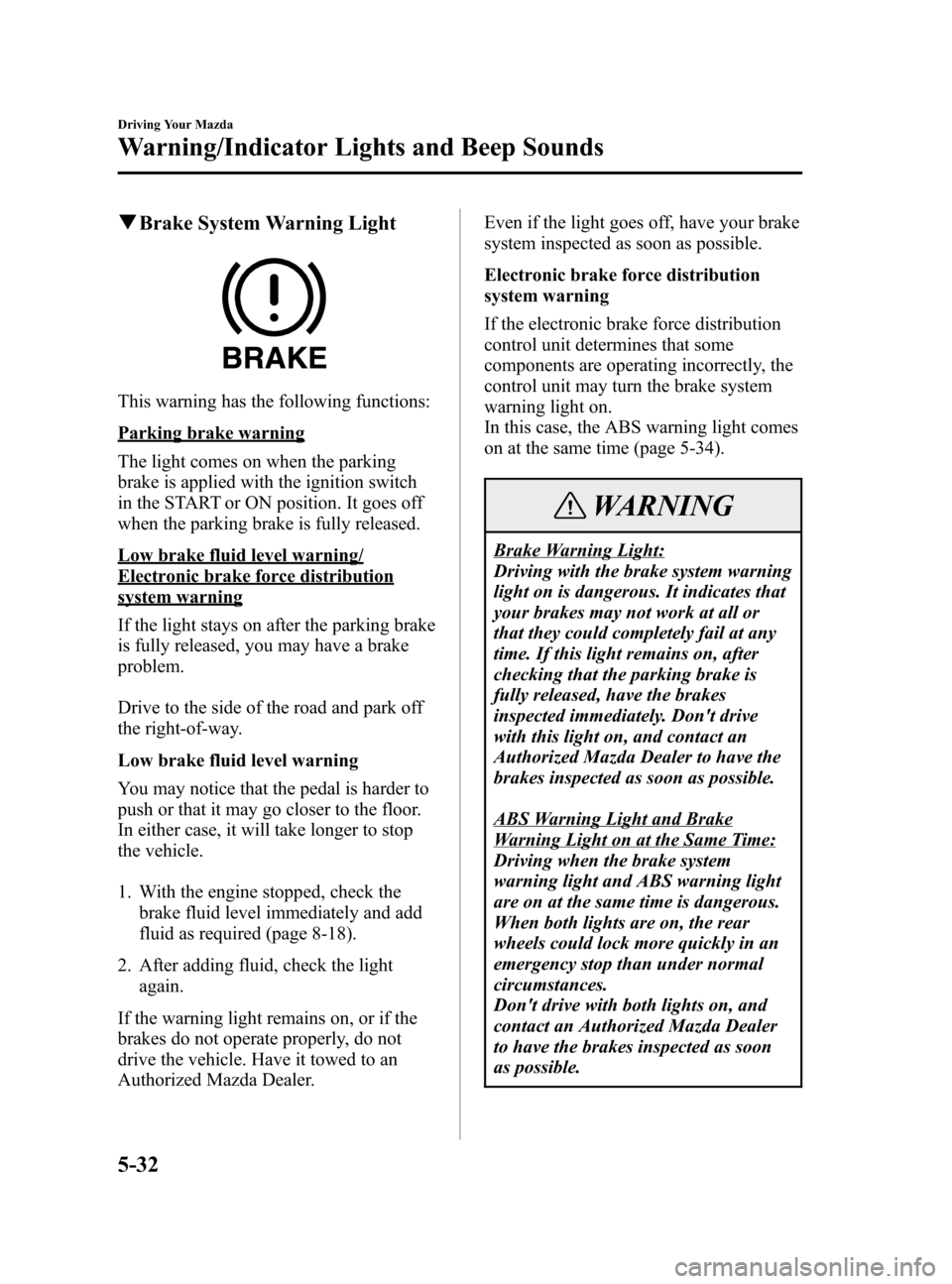
Black plate (142,1)
qBrake System Warning Light
This warning has the following functions:
Parking brake warning
The light comes on when the parking
brake is applied with the ignition switch
in the START or ON position. It goes off
when the parking brake is fully released.
Low brake fluid level warning/
Electronic brake force distribution
system warning
If the light stays on after the parking brake
is fully released, you may have a brake
problem.
Drive to the side of the road and park off
the right-of-way.
Low brake fluid level warning
You may notice that the pedal is harder to
push or that it may go closer to the floor.
In either case, it will take longer to stop
the vehicle.
1. With the engine stopped, check the
brake fluid level immediately and add
fluid as required (page 8-18).
2. After adding fluid, check the light
again.
If the warning light remains on, or if the
brakes do not operate properly, do not
drive the vehicle. Have it towed to an
Authorized Mazda Dealer.Even if the light goes off, have your brake
system inspected as soon as possible.
Electronic brake force distribution
system warning
If the electronic brake force distribution
control unit determines that some
components are operating incorrectly, the
control unit may turn the brake system
warning light on.
In this case, the ABS warning light comes
on at the same time (page 5-34).
WARNING
Brake Warning Light:
Driving with the brake system warning
light on is dangerous. It indicates that
your brakes may not work at all or
that they could completely fail at any
time. If this light remains on, after
checking that the parking brake is
fully released, have the brakes
inspected immediately. Don't drive
with this light on, and contact an
Authorized Mazda Dealer to have the
brakes inspected as soon as possible.
ABS Warning Light and Brake
Warning Light on at the Same Time:
Driving when the brake system
warning light and ABS warning light
are on at the same time is dangerous.
When both lights are on, the rear
wheels could lock more quickly in an
emergency stop than under normal
circumstances.
Don't drive with both lights on, and
contact an Authorized Mazda Dealer
to have the brakes inspected as soon
as possible.
5-32
Driving Your Mazda
Warning/Indicator Lights and Beep Sounds
Mazda3_8T97-EC-04J_Edition1 Page142
Saturday, September 25 2004 2:10 PM
Form No.8T97-EC-04J
Page 144 of 322
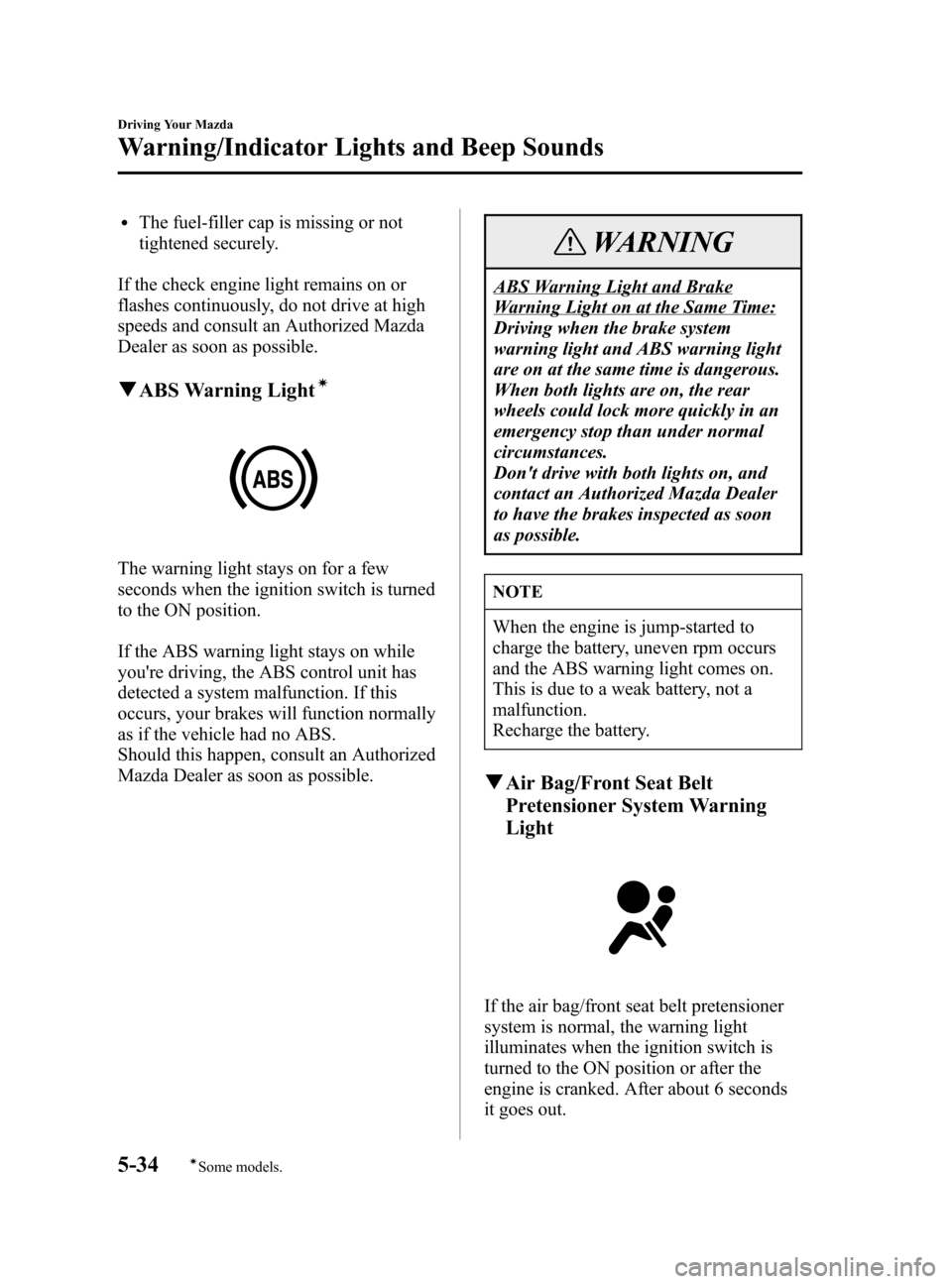
Black plate (144,1)
lThe fuel-filler cap is missing or not
tightened securely.
If the check engine light remains on or
flashes continuously, do not drive at high
speeds and consult an Authorized Mazda
Dealer as soon as possible.
qABS Warning Lightí
The warning light stays on for a few
seconds when the ignition switch is turned
to the ON position.
If the ABS warning light stays on while
you're driving, the ABS control unit has
detected a system malfunction. If this
occurs, your brakes will function normally
as if the vehicle had no ABS.
Should this happen, consult an Authorized
Mazda Dealer as soon as possible.
WARNING
ABS Warning Light and Brake
Warning Light on at the Same Time:
Driving when the brake system
warning light and ABS warning light
are on at the same time is dangerous.
When both lights are on, the rear
wheels could lock more quickly in an
emergency stop than under normal
circumstances.
Don't drive with both lights on, and
contact an Authorized Mazda Dealer
to have the brakes inspected as soon
as possible.
NOTE
When the engine is jump-started to
charge the battery, uneven rpm occurs
and the ABS warning light comes on.
This is due to a weak battery, not a
malfunction.
Recharge the battery.
qAir Bag/Front Seat Belt
Pretensioner System Warning
Light
If the air bag/front seat belt pretensioner
system is normal, the warning light
illuminates when the ignition switch is
turned to the ON position or after the
engine is cranked. After about 6 seconds
it goes out.
5-34
Driving Your Mazda
íSome models.
Warning/Indicator Lights and Beep Sounds
Mazda3_8T97-EC-04J_Edition1 Page144
Saturday, September 25 2004 2:10 PM
Form No.8T97-EC-04J
Page 233 of 322

Black plate (233,1)
Scheduled Maintenance (North America)
Follow Schedule 1 if the vehicle is operated mainly where none of the following conditions
apply.
If any do apply, follow Schedule 2 (Canada and Puerto Rico residents follow Schedule 2).
lRepeated short-distance driving
lDriving in dusty conditions
lDriving with extended use of brakes
lDriving in areas where salt or other corrosive materials are being used
lDriving on rough or muddy roads
lExtended periods of idling or low-speed operation
lDriving for long periods in cold temperatures or extremely humid climates
NOTE
After the prescribed period, continue to follow the described maintenance at the
recommended intervals.
Maintenance and Care
Scheduled Maintenance
8-3
Mazda3_8T97-EC-04J_Edition1 Page233
Saturday, September 25 2004 2:15 PM
Form No.8T97-EC-04J
Page 234 of 322
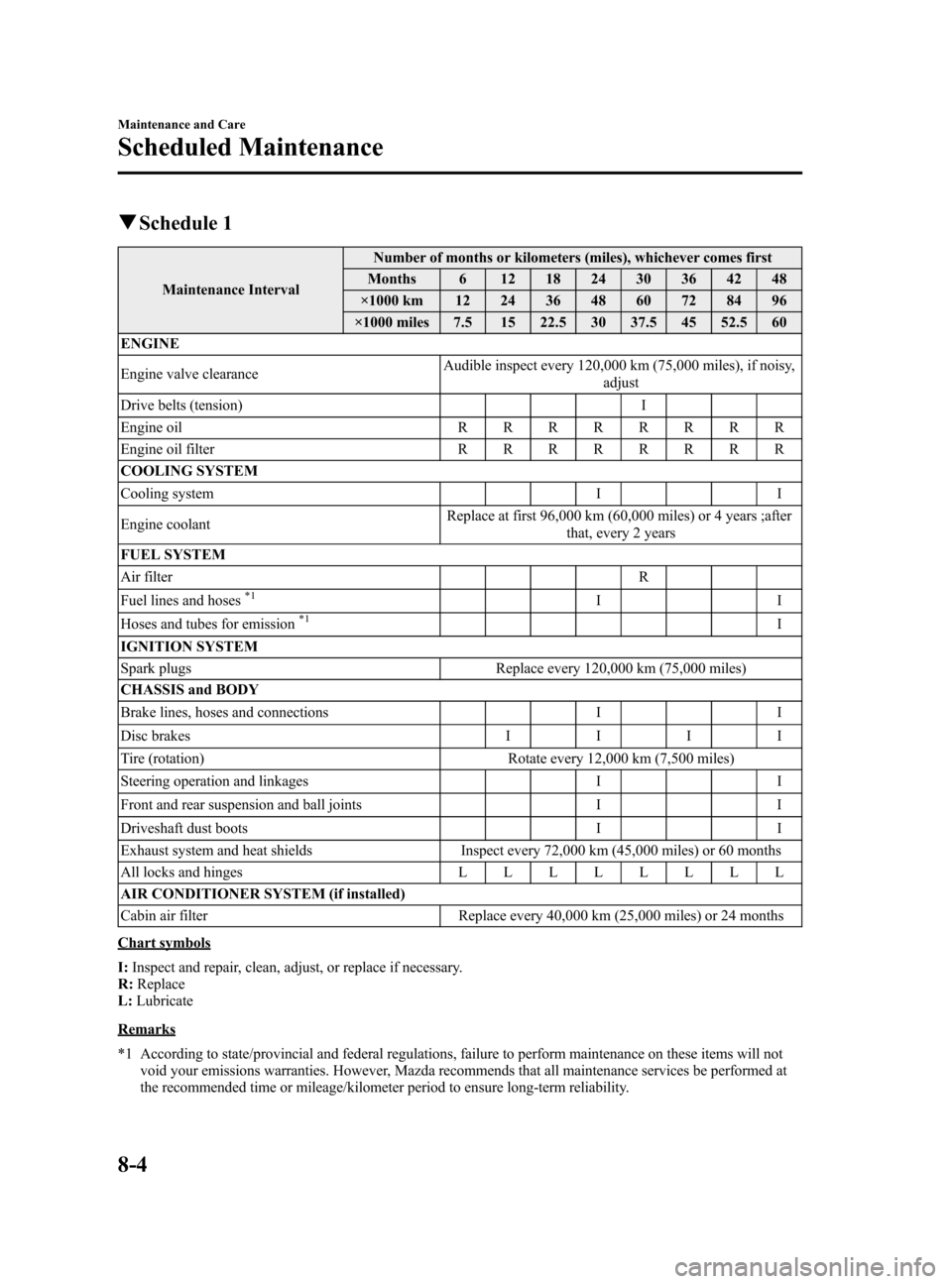
Black plate (234,1)
qSchedule 1
Maintenance IntervalNumber of months or kilometers (miles), whichever comes first
Months 6 12 18 24 30 36 42 48
×1000 km 12 24 36 48 60 72 84 96
×1000 miles 7.5 15 22.5 30 37.5 45 52.5 60
ENGINE
Engine valve clearanceAudible inspect every 120,000 km (75,000 miles), if noisy,
adjust
Drive belts (tension) I
Engine oil R R R R R R R R
Engine oil filter R R R R R R R R
COOLING SYSTEM
Cooling system I I
Engine coolantReplace at first 96,000 km (60,000 miles) or 4 years ;after
that, every 2 years
FUEL SYSTEM
Air filter R
Fuel lines and hoses
*1II
Hoses and tubes for emission*1I
IGNITION SYSTEM
Spark plugs Replace every 120,000 km (75,000 miles)
CHASSIS and BODY
Brake lines, hoses and connections I I
Disc brakes I I I I
Tire (rotation) Rotate every 12,000 km (7,500 miles)
Steering operation and linkages I I
Front and rear suspension and ball joints I I
Driveshaft dust boots I I
Exhaust system and heat shields Inspect every 72,000 km (45,000 miles) or 60 months
All locks and hinges L L L L L L L L
AIR CONDITIONER SYSTEM (if installed)
Cabin air filter Replace every 40,000 km (25,000 miles) or 24 months
Chart symbols
I:Inspect and repair, clean, adjust, or replace if necessary.
R:Replace
L:Lubricate
Remarks
*1 According to state/provincial and federal regulations, failure to perform maintenance on these items will not
void your emissions warranties. However, Mazda recommends that all maintenance services be performed at
the recommended time or mileage/kilometer period to ensure long-term reliability.
8-4
Maintenance and Care
Scheduled Maintenance
Mazda3_8T97-EC-04J_Edition1 Page234
Saturday, September 25 2004 2:15 PM
Form No.8T97-EC-04J
Page 235 of 322
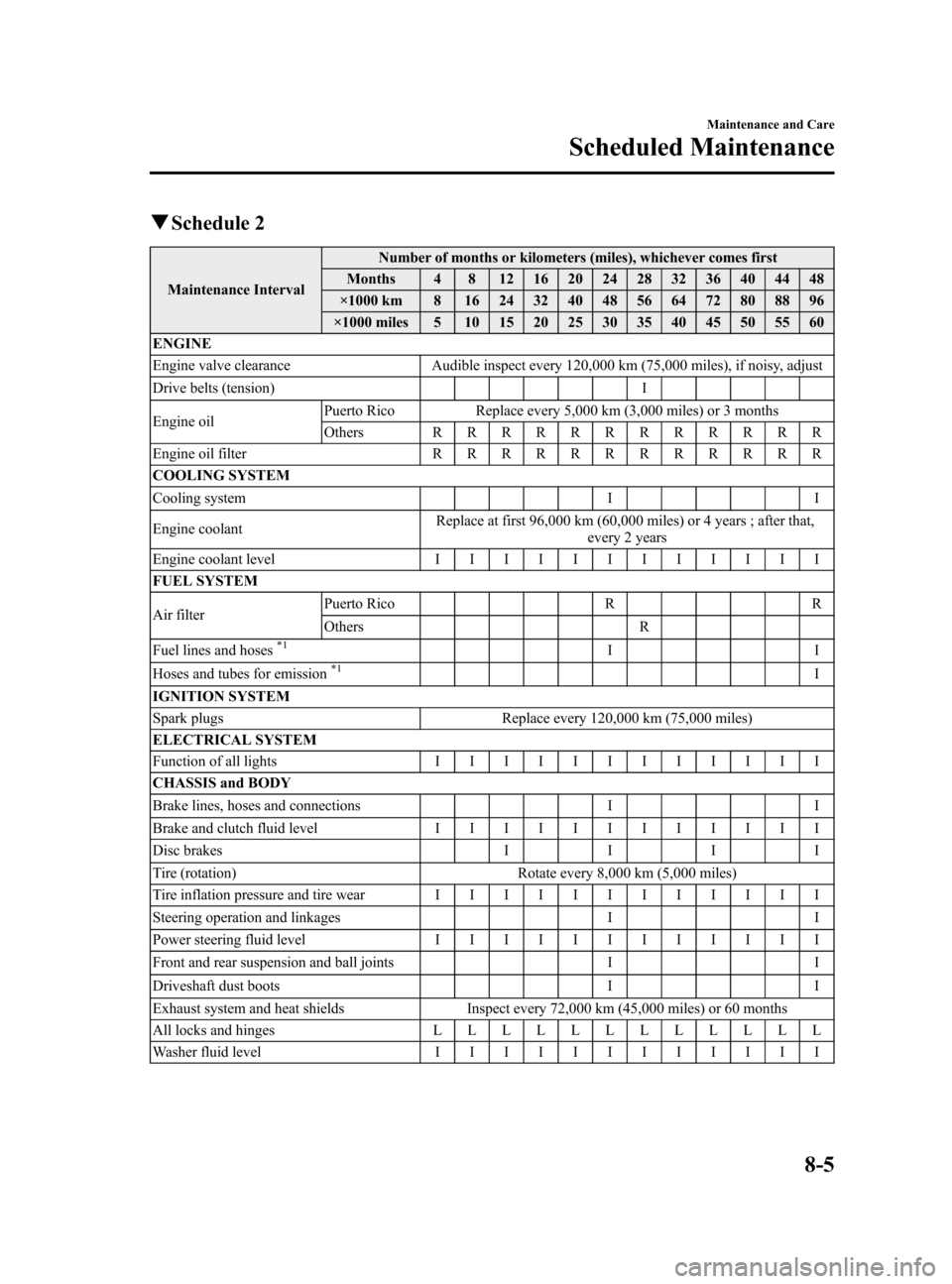
Black plate (235,1)
qSchedule 2
Maintenance IntervalNumber of months or kilometers (miles), whichever comes first
Months 4 8 12 16 20 24 28 32 36 40 44 48
×1000 km 8 16 24 32 40 48 56 64 72 80 88 96
×1000 miles 5 10 15 20 25 30 35 40 45 50 55 60
ENGINE
Engine valve clearance Audible inspect every 120,000 km (75,000 miles), if noisy, adjust
Drive belts (tension) I
Engine oilPuerto Rico Replace every 5,000 km (3,000 miles) or 3 months
Others R R R R R R RRRRRR
Engine oil filter R R R R R R RRRRRR
COOLING SYSTEM
Cooling system I I
Engine coolantReplace at first 96,000 km (60,000 miles) or 4 years ; after that,
every 2 years
Engine coolant level I I I I I I IIIIII
FUEL SYSTEM
Air filterPuerto Rico R R
Others R
Fuel lines and hoses
*1II
Hoses and tubes for emission*1I
IGNITION SYSTEM
Spark plugs Replace every 120,000 km (75,000 miles)
ELECTRICAL SYSTEM
Function of all lights I I I I I I IIIIII
CHASSIS and BODY
Brake lines, hoses and connections I I
Brake and clutch fluid level I I I I I I IIIIII
Disc brakesIIII
Tire (rotation) Rotate every 8,000 km (5,000 miles)
Tire inflation pressure and tire wear I I I I I I IIIIII
Steering operation and linkages I I
Power steering fluid level I I I I I I IIIIII
Front and rear suspension and ball joints I I
Driveshaft dust boots I I
Exhaust system and heat shields Inspect every 72,000 km (45,000 miles) or 60 months
All locks and hinges L L L L L LLLLLLL
Washer fluid level I I I I I I IIIIII
Maintenance and Care
Scheduled Maintenance
8-5
Mazda3_8T97-EC-04J_Edition1 Page235
Saturday, September 25 2004 2:15 PM
Form No.8T97-EC-04J
Page 238 of 322

Black plate (238,1)
qSchedule
Maintenance IntervalNumber of months or kilometers (miles), whichever comes first
Months 6 12 18 24 30 36 42 48 54 60 66 72 78 84 90 96
×1000 km 10 20 30 40 50 60 70 80 90 100 110 120 130 140 150 160
×1000 miles
6.25 12.5 18.752531.25 37.5 43.755056.25 62.5 68.757581.25 87.5 93.75100
Engine valve clearance Audible inspect every 120,000 km (75,000 miles), if noisy, adjust
Drive belts
*1IIIIIIIIIIIIIIII
Engine oil*2RRRRRRRRRRRRRRRR
Engine oil filter*2RRRRRRRRRRRRRRRR
Cooling system I I I I I I I I
Engine coolant Replace every 2 years
Air filter
*3CCRCCRCC
Spark plugs
*6Iridium type Replace every 120,000 km (75,000 miles)
except
Iridium typeRRRR
Idle speed (ZJ, ZY and Z6 engine) I I I I I I I I
Fuel filterRRRR
Fuel lines and hoses I I I I I I I I
Evaporative system (if installed) I I I I I I I I
Battery electrolyte level and specific
gravityIIIIIIII
Brake lines, hoses and connections I I I I I I I I
Brake fluid
*4IIIRIIIRIIIRIIIR
Parking brake I I IIIIIIIIIIIIII
Power brake unit (Brake booster)
and hosesIIIIIIII
Disc brakes I I IIIIIIIIIIIIII
Drum brakes (if installed) I I I I I I I I
Power steering fluid, lines, hoses
and connectionsIIIIIIIIIIIIIIII
Steering operation and linkage I I I I I I I I
Manual transaxle oil R
Automatic transaxle fluid level I I I I I I I I
Front and rear suspension and ball
jointsIIII
Driveshaft dust bootsIIII
Exhaust system and heat shields Inspect every 80,000 km (50,000 miles)
Bolts and nuts on chassis and body T T T T T T T T
All electrical system
*5IIIIIIII
Body condition
(for rust, corrosion and perforation)Inspect annually
8-8
Maintenance and Care
Scheduled Maintenance
Mazda3_8T97-EC-04J_Edition1 Page238
Saturday, September 25 2004 2:16 PM
Form No.8T97-EC-04J
Page 239 of 322
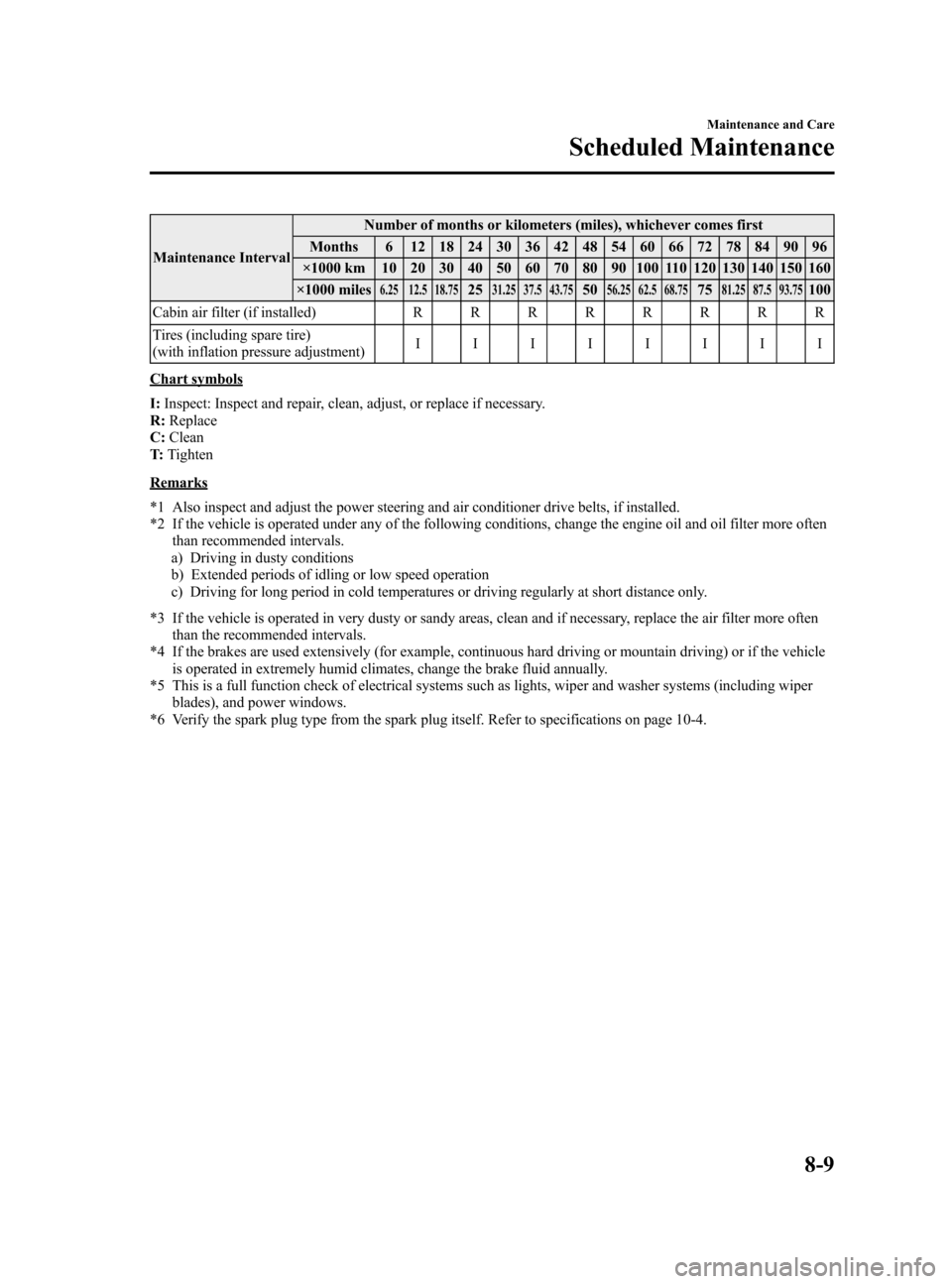
Black plate (239,1)
Maintenance IntervalNumber of months or kilometers (miles), whichever comes first
Months 6 12 18 24 30 36 42 48 54 60 66 72 78 84 90 96
×1000 km 10 20 30 40 50 60 70 80 90 100 110 120 130 140 150 160
×1000 miles
6.25 12.5 18.752531.25 37.5 43.755056.25 62.5 68.757581.25 87.5 93.75100
Cabin air filter (if installed) R R R R R R R R
Tires (including spare tire)
(with inflation pressure adjustment)IIIIIIII
Chart symbols
I:Inspect: Inspect and repair, clean, adjust, or replace if necessary.
R:Replace
C:Clean
T:Tighten
Remarks
*1 Also inspect and adjust the power steering and air conditioner drive belts, if installed.
*2 If the vehicle is operated under any of the following conditions, change the engine oil and oil filter more often
than recommended intervals.
a) Driving in dusty conditions
b) Extended periods of idling or low speed operation
c) Driving for long period in cold temperatures or driving regularly at short distance only.
*3 If the vehicle is operated in very dusty or sandy areas, clean and if necessary, replace the air filter more often
than the recommended intervals.
*4 If the brakes are used extensively (for example, continuous hard driving or mountain driving) or if the vehicle
is operated in extremely humid climates, change the brake fluid annually.
*5 This is a full function check of electrical systems such as lights, wiper and washer systems (including wiper
blades), and power windows.
*6 Verify the spark plug type from the spark plug itself. Refer to specifications on page 10-4.
Maintenance and Care
Scheduled Maintenance
8-9
Mazda3_8T97-EC-04J_Edition1 Page239
Saturday, September 25 2004 2:16 PM
Form No.8T97-EC-04J
Page 248 of 322

Black plate (248,1)
4. Drain the system completely. Insert and
tighten the plug. Add as much
ethylene-glycol-based coolant mixture
and water as necessary to provide
freezing and corrosion protection.
5. In extremely cold climates, add the
mixture percentage recommended in
the coolant mixture percentage table.
6. Run the engine at idle with the cooling
system cap off. Slowly add additional
coolant if necessary.
7. At this point, wait until the engine
reaches normal operating temperature;
then depress the accelerator two or
three times. Add more coolant, if
necessary, until the system is full.
8. Install the cooling system cap. Inspect
all connections for leaks. Inspect the
level in the coolant reservoir one more
time.Brake/Clutch Fluid
qInspecting Brake/Clutch Fluid
Level
The brakes and clutch draw fluid from the
same reservoir.
Inspect the fluid level in the reservoir
regularly. It should be kept at MAX.
The level normally drops with
accumulated distance, a condition
associated with wear of brake and clutch
linings. If it is excessively low, have the
brake/clutch system inspected by an
Authorized Mazda Dealer.
8-18
Maintenance and Care
Owner Maintenance
Mazda3_8T97-EC-04J_Edition1 Page248
Saturday, September 25 2004 2:16 PM
Form No.8T97-EC-04J
Page 249 of 322
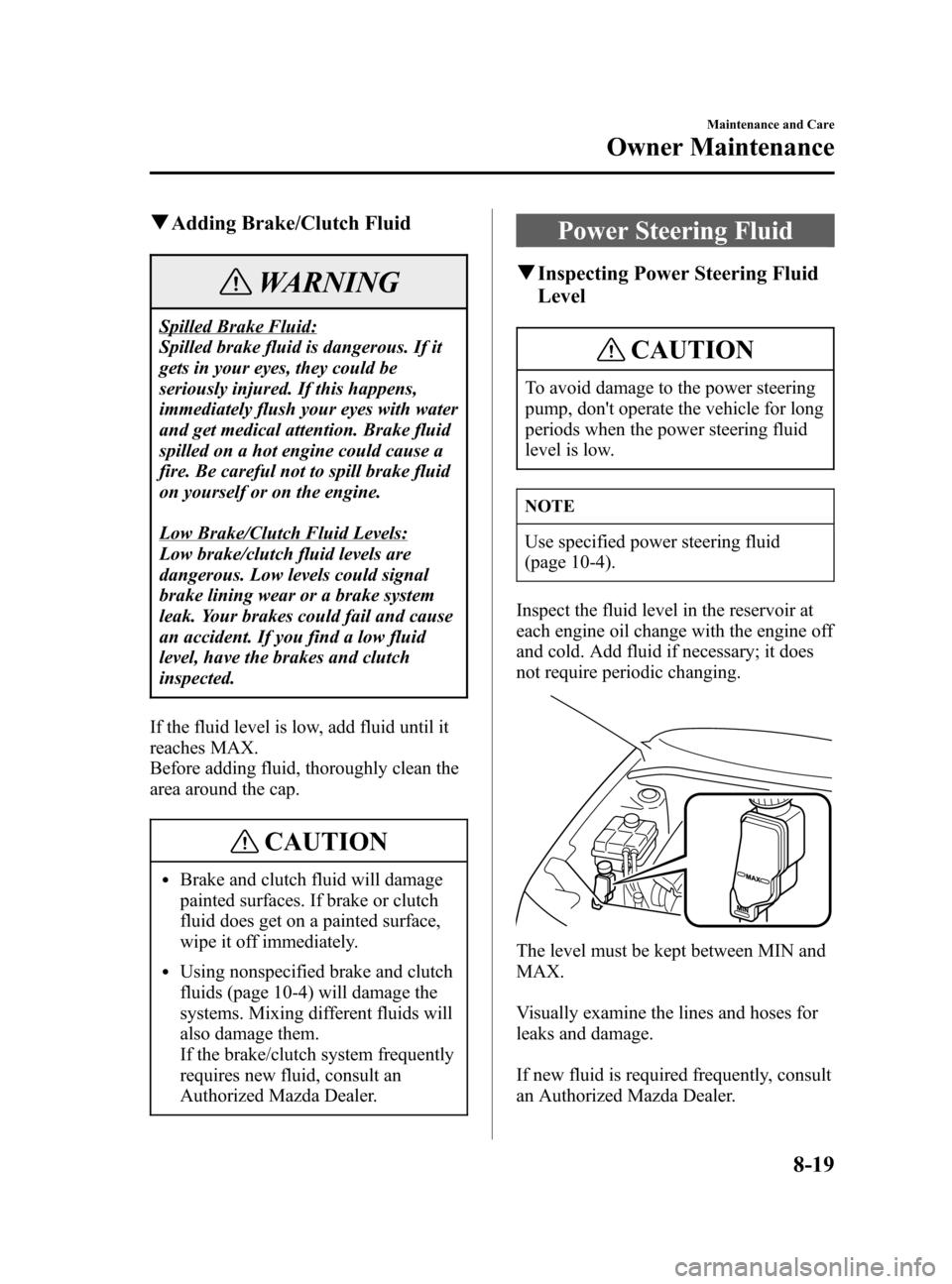
Black plate (249,1)
qAdding Brake/Clutch Fluid
WARNING
Spilled Brake Fluid:
Spilled brake fluid is dangerous. If it
gets in your eyes, they could be
seriously injured. If this happens,
immediately flush your eyes with water
and get medical attention. Brake fluid
spilled on a hot engine could cause a
fire. Be careful not to spill brake fluid
on yourself or on the engine.
Low Brake/Clutch Fluid Levels:
Low brake/clutch fluid levels are
dangerous. Low levels could signal
brake lining wear or a brake system
leak. Your brakes could fail and cause
an accident. If you find a low fluid
level, have the brakes and clutch
inspected.
If the fluid level is low, add fluid until it
reaches MAX.
Before adding fluid, thoroughly clean the
area around the cap.
CAUTION
lBrake and clutch fluid will damage
painted surfaces. If brake or clutch
fluid does get on a painted surface,
wipe it off immediately.
lUsing nonspecified brake and clutch
fluids (page 10-4) will damage the
systems. Mixing different fluids will
also damage them.
If the brake/clutch system frequently
requires new fluid, consult an
Authorized Mazda Dealer.
Power Steering Fluid
qInspecting Power Steering Fluid
Level
CAUTION
To avoid damage to the power steering
pump, don't operate the vehicle for long
periods when the power steering fluid
level is low.
NOTE
Use specified power steering fluid
(page 10-4).
Inspect the fluid level in the reservoir at
each engine oil change with the engine off
and cold. Add fluid if necessary; it does
not require periodic changing.
The level must be kept between MIN and
MAX.
Visually examine the lines and hoses for
leaks and damage.
If new fluid is required frequently, consult
an Authorized Mazda Dealer.
Maintenance and Care
Owner Maintenance
8-19
Mazda3_8T97-EC-04J_Edition1 Page249
Saturday, September 25 2004 2:16 PM
Form No.8T97-EC-04J
Page 285 of 322

Black plate (285,1)
CAUTION
lDon't use steel wool, abrasive
cleaners, or strong detergents
containing highly alkaline or caustic
agents on chrome-plated or anodized
aluminum parts. This may damage
the protective coating; also, cleaners
and detergents may discolor or
deteriorate the paint.
lTo prevent damaging the antenna,
remove it before entering a car wash
facility or passing beneath a low
overhead clearance.
Pay special attention to removing salt,
dirt, mud, and other foreign material from
the underside of the fenders, and make
sure the drain holes in the lower edges of
the doors and rocker panels are clean.
Insects, tar, tree sap, bird droppings,
industrial fallout, and similar deposits can
damage the finish if not removed
immediately. When prompt washing with
plain water is ineffective, use a mild soap
made for use on vehicles.
Thoroughly rinse off all soap with
lukewarm or cold water. Don't allow soap
to dry on the finish.
After washing the vehicle, dry it with a
clean chamois to prevent water spots from
forming.
WARNING
Driving with Wet Brakes:
Driving with wet brakes is dangerous.
Increased stopping distance or the
vehicle pulling to one side when
braking could result in a serious
accident. Light braking will indicate
whether the brakes have been affected.
Dry the brakes by driving very slowly
and applying the brakes lightly until
brake performance is normal.
Waxing
Your vehicle needs to be waxed when
water no longer beads on the finish.
Always wash and dry the vehicle before
waxing it. In addition to the vehicle body,
wax the metal trim to maintain its luster.
1. Use wax which contains no abrasives.
Waxes containing abrasive will remove
paint and could damage bright metal
parts.
2. Use a good grade of natural wax for
metallic, mica, and solid colors.
3. When waxing, coat evenly with the
sponge supplied or a soft cloth.
4. Wipe off the wax with a soft cloth.
NOTE
A spot remover to remove oil, tar, and
similar materials will usually also take
off the wax. Rewax these areas even if
the rest of the vehicle doesn't need it.
Maintenance and Care
Appearance Care
8-55
Mazda3_8T97-EC-04J_Edition1 Page285
Saturday, September 25 2004 2:17 PM
Form No.8T97-EC-04J